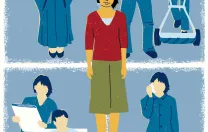Today’s American girls and young women may be the daughters of feminism, but their world isn’t always the one envisioned by their foremothers. “Little girls dress in pink and they’re princesses, but at the same time they’re going to grow up to wear five-inch heels and kick ass!” says Lee professor of economics Claudia Goldin, an old-school feminist who wants more equality, not difference, between the sexes. The rise of “girl power” and the celebration of “difference”—propelled by forces ranging from Title IX to feminist punk-rock bands—have changed American culture, although not all girls have benefited equally.
The struggle for women’s rights in the United States is often described in terms of “waves.” First-wave feminism culminated with women’s suffrage in 1920, while the resurgent second-wave feminism of the 1960s and ’70s focused on reproductive freedom, sexual harassment, equal pay, and access to education and jobs. The second-wave mother of the girls’ movement was Carol Gilligan, formerly Graham professor of gender studies at Harvard Graduate School of Education, whose book on women’s psychological development, In a Different Voice (1982), inspired countless studies on girls and sweeping educational changes. Another second-wave development was Title IX.
“My students have been deeply touched by Title IX” and its expectation that girls would participate in sports equally to boys, says assistant professor of studies of women, gender, and sexuality and of history and literature Robin Bernstein, when asked about girls’ self-esteem. Her work in performance studies examines “what people do with bodies.” Athletics, she says, significantly changes a girl’s relationship with her body. To help her students understand the law’s impact, she tells them that in the 1970s, “a sports bra was a specialized piece of sports equipment, not something you could buy at any department store—which speaks to a huge change in expectations for women and athletics.” People don’t recognize Title IX’s impact, she adds, “not just on female athletes who made varsity or went on to the Olympics, but on the masses of girls who grew up with the expectation, ‘Sure, I’ll play soccer. Why not?’”
Female sports participation has skyrocketed since Richard Nixon signed Title IX of the 1972 Educational Amendments to the 1964 Civil Rights Act into law—by 450 percent in college and an astounding 900 percent in high school (to 2.9 million girls) in 2005-2006. (Not everyone has benefited as intended. For inner-city girls, for example, sports fields are often nonexistent and schools can’t afford the expense of equipment, lessons, and travel.)
Furthermore, Title IX is not just about sports. It not only bans bias (in recruitment, financial aid, benefits, and scholarships) against either sex in any educational setting receiving federal aid, it also outlaws sexual harassment and protects equal access to math and science, higher education, career training, technology, and employment. Wendy Luttrell, Aronson associate professor in human development and education and the author of Pregnant Bodies, Fertile Minds: Gender, Race, and the Schooling of Pregnant Teens (2003), notes that “Title IX was also initiated so that pregnant girls could stay in school.” (Public schools used to expel pregnant students and bar visibly pregnant teachers from classrooms. “Title IX got rid of the de jure discrimination that pregnant girls cannot be in school,” Luttrell says, “but de facto discrimination”—either isolating the girls from resources and regular classes, or mainstreaming them without support—“is still quite prevalent.”)
While the effects of Title IX were taking hold, a “third wave” of American feminism—advocating “difference” and “girl-ness”—was rising. Feminist performance artists like the Guerrilla Girls and the V-Girls reclaimed the word “girl” in the 1980s, and in the early 1990s, the punk band Bikini Kill famously put the grrr into “grrrl” and helped catalyze a movement of Riot Grrrls. Young third-wavers resisted sexism through their music, the Internet, and grass-roots activism, on the one hand, and on the other, through a “girlie” feminism that championed “girl stuff,” from Barbie dolls and high heels to knitting.
“Girl Power,” the third wave’s best-known catch phrase, went mainstream as the slogan for the British pop group the Spice Girls. The U.S. Department of Health and Human Services even named its first girl-centered public-health initiative Girl Power! (www.girlpower.gov). Today girls’ programming includes cultural staples like the Ms. Foundation’s original Take Our Daughters to Work Day (now Take Our Daughters and Sons to Work Day) and organizations like Strong Women, Strong Girls (SWSG).
Even the preferred sex of infants has acquired a girl-power spin. “Now people say, ‘Oh, I’m having a boy. This is going to be so difficult,’” says Goldin. “We’ve seen a huge shift in what is considered to be the perfect child—little girls are just ‘easier,’ they’re ‘smarter,’ they ‘mature faster.’” Popular treatments of sex-difference research may be responsible: “Men, Get Ready to Develop Brain Envy,” declares the back cover of The Female Brain, by neuropsychiatrist Louann Brizendine, a former Harvard Medical School resident and professor.
Brizendine has found a generational divide in the response to her work on this biology-psychology connection. Girls and women under 30 send grateful e-mails, she says: “Younger women have come up in the world not thinking they have limitations on their intellect at all. They’ve embraced their own intelligence, and they’re moving forward.” But women of her own over-50 generation “don’t like it. They’re afraid the message will hurt women instead of help them. If you say anything about difference, it means unequal, and unequal means women lose.” Brizendine was a second-waver, but now, she says, “I call myself a third-wave feminist, which means embracing and celebrating the differences.”
Whatever the wave, few daughters of feminism identify themselves by the “f-word,” as Dan Kindlon, clinical psychologist and adjunct lecturer at the Harvard School of Public Health, found among the alpha girls he studies. SWSG’s Lindsay Hyde ’04 reports that her volunteer mentors “have really differing levels of comfort with what feminism means.” Demonizing rants against “male-bashing feminazis” are partly to blame, so SWSG organizationally defines feminism, which “has become such a flash point in the political realm, as ‘ensuring that everyone, men and women, have access to the resources they need to make positive choices in their lives,’” says Hyde. “Using that definition, I absolutely consider myself a feminist.”










